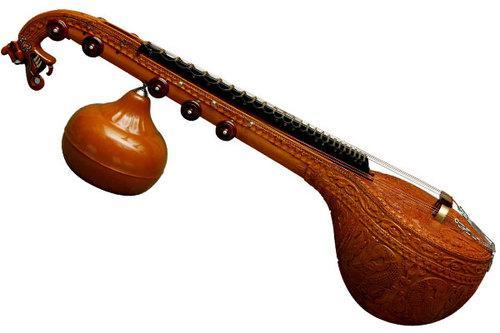Veena lessons
The Saraswati veena is an Indian string instrument. It is named
after the Hindu goddess Saraswati, who is usually depicted holding
or playing the instrument. Also known as Raghunatha veena.
There are several variations of the veena, which in its South Indian
form is a member of the lute family. Keyboard is convienient for small children or for adults.
We offer carnatic music lessons with
keyboard/harmonium to children and adults minimum age 5 1/2. Vocal
is also taught along with keyboard or harmonium. Students are taught
fingering techniques along with raga and tala as in any carnatic
instrument. It is a very melodious instrument and light to play for
small children as well as adults.

How to buy keyboard?
We recommend Casio 61-Key Full-Sized Keyboard. You are welcome to
purchase it in a local store or online.
What else do I need?
You would need a metronome and a three ring binder with sheet
protectors to hold music notes. Bring the binder to every class.
What is the structure of the classes?
All students start off as private classes till they are ready to
catch up with the group at the discretion of
Kalabharati. Priliminary private classes are 30mt. Classes are
tailored to the needs and abilities of the student. If you prefer to
continue in private lessons they are double the group rate.
Group classes are 45mt long.
Location:
Our studio is located near the intersection of New Territory Blvd
and Homeward Way behind Sartartia Middle School.
For Registration form please click
here
Fees:
At the first lesson of each month you pay for all the lessons in
that month (4 lessons). We accept cash or check only. Checks are
made payable to Kalabharati. If you join classes later than the
first week of the month, tuition will be prorated for the first
month. Prorating for family vacations or emergencies may be done
once a year per student.
Once a year School program mandatory fee: $25.00 paid at the first
class of the year or when you join Kalabharati. This is a great
opportunity for students to show off their talents and musical
progress. We are proud of every student!
Dress Code:
Comfortable loose fitting long skirt or pants.
Makeup Policy:
If a student does not contact us with their absence beforehand and
does not show up for a lesson, that lesson will be forfeited.
Tuition credit is not given for missed classes. Please realize our
time to teach is limited and you are paying for and reserving our
time each week. You may makeup one lesson each month. If you do not
show up for a lesson or fail to notify in advance requesting makeup
class you will lose that lesson. Notification Text: 713-540-6310
Notification Email:
lesssons@kalabharati.org
One make up class is allowed for one month. Makeup classes are the
first week of next month. If you cannot make it up you forfeit the
makeup class.
Music instruments makeup: Wed 7pm
Contact us:
Often we are teaching lessons and cannot answer the phone. Please
leave a message with your question. For a faster response, we
encourage you to use email lessons@kalabharati.org.
Other popular types of veena are chitraveena, vichitra veena,
mohanaveena and rudra veena. Out of these
the rudra and vichitra veenas are used in Hindustani music. People
play both traditional and contemporary music on veena.
Veena construction: About four feet in length, its design
consists of a large resonator kudam carved and hollowed out of a log usually of jackwood or any other locally available wood, a tapering hollow
neck called dandi is topped with 24 brass or bell-metal frets set in
scalloped black wax. A tuning box culminating
in a downward curve and an ornamental dragons head is called yali.
If the veena is built from a single piece of wood it is called ekandaveena. Else it is called kanda veena or ottu veena, now there are
electric veena and veenas with guitar pegs.
A small table-like wooden bridge called kudurai—about 2 x 2½ x 2 inches—is topped by a convex brass plate glued in place with resin. Two rosettes, formerly of ivory, now of plastic or horn, are on the top board palakai of the resonator.
Four main playing strings tuned to the tonic and the fifth in two
octaves for example, B flat-E flat below bass clef - B flat- E flat
in bass clef stretch from fine tuning connectors attached to the
end of the resonator across the bridge and above the fretboard to
four large-headed pegs in the tuning box. Three subsidiary drone
strings tuned to the tonic, fifth, and upper tonic (E flat - B flat-
E flat in the tuning given above) cross a curving side bridge
leaning against the main bridge, and stretch on the players side of
the neck to three pegs matching those of the main playing strings.
All seven strings today are of steel, with the lower strings either
solid thick gauge wire or round wound.


